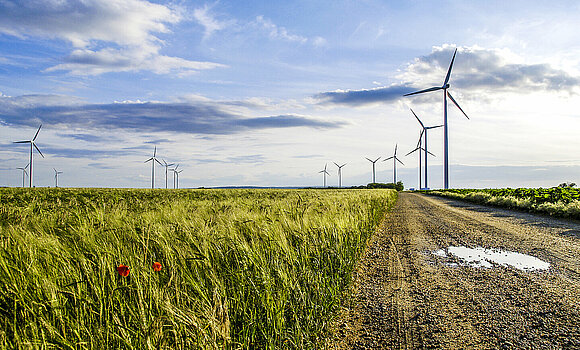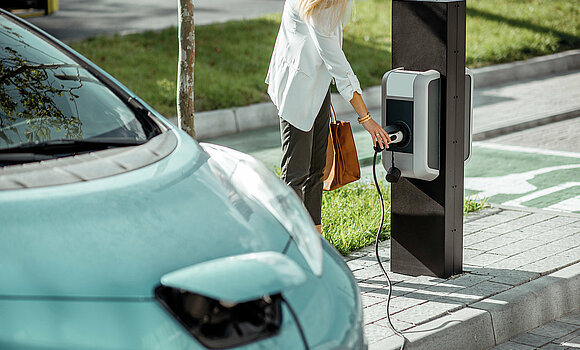Fit for 55
Initial recommendations of the electricity industry
The Austrian electricity sector is committed to meeting the national energy and climate target of generating all electricity from renewable sources by 2030 and achieving climate neutrality by 2040. The Green Deal is designed to bring about EU-wide climate neutrality by 2050. As part of the roadmap for this objective, the target reduction in CO2 has been adjusted to 55% by 2030.
The European Commission has announced that it will devise a framework for realising the Green Deal within the Fit for 55 package of measures, which is aimed primarily at three areas: CO2 pricing, clean energy and transport.
In order to actually hit national and European climate goals, greater efforts will be required across all sectors and in all member states. In all of the planned measures, the challenges of energy supply security, affordability and social equilibrium for consumers must be taken into account.
Putting a price on CO2 is an essential element of the necessary transformation process. The primary objective should be to implement European solutions, in order to avoid compromising the member states’ competitiveness. In this context, the interplay between the available instruments (EU Emission Trading Scheme, the Effort-sharing Regulation and energy taxation) needs to be borne in mind. The double or even multiple counting of generating facilities must be avoided. Taxation and the auction of emission allowances generate income that should be used to finance emission-reduction measures and minimise possible negative distribution effects.
Decarbonising the energy system will also pose huge challenges for system operators. The additional demands placed on grids, in particular as a result of the expected growth in the number of decentralised renewable generating plants and the increased prevalence of electromobility will necessitate significant investment over the coming years.
The recovery plan will provide an opportunity to plot a course for the climate-friendly remodelling of the energy system. Investment in this process will help the economy to pick up momentum and create jobs. Realigning the energy system towards renewables – through investments in hydro, wind and solar power – is not only crucial for the achievement of climate targets, it will also add jobs and enhance value creation.
We believe the following points are central in the revision of the various legislative acts:
Emission Trading Directive
- Regarding the distribution of additional reductions in emissions, a balance needs to be struck between sectors covered by the ETS and those not included in the scheme.
- The linear reduction factor would need to be increased, and based on 1990 levels, in order to achieve the ambitious target of a 55% reduction in CO2 emissions by 2030.
- Income from the ETS should be earmarked for specific purposes in order to finance measures aimed at cutting emissions – which could also be funded by topping up the Innovation Fund – and reducing potential negative distribution effects.
- Regarding extension of the ETS to the transport and building sectors, impact assessments will be necessary to evaluate which approach (extending the current ETS, a separate ETS or CO2 taxation) would be the most effective instrument for reducing emissions.
- Oesterreichs Energie is in favour of Europe-wide CO2 pricing for the transport and heating sectors, neither of which is currently covered by the ETS. Emissions trading has evolved continuously and any extension should not impair its continued functioning. We recommend that the European Commission develops options for this approach and presents its analysis in an impact assessment.

- In addition, the list of sectors at significant risk of carbon leakage should be reviewed in the course of revising the Emission Trading Directive and introducing the carbon border adjustment mechanism. As there are wide variations in the emissions generated by the various hydrogen production processes, hydrogen production should not receive free allocations of emission allowances across the board.
Effort-sharing Regulation
- The targets for the member states must not be determined only on the basis of GDP. Instead, the aim should be to capitalise on potential where CO2 avoidance costs are lowest. Continuing the GDP-based allocation carries the risk that lock-in effects will be amplified, meaning that investment will not be steered towards climate-friendly technologies.
- The double or even multiple counting of generating facilities which are already included in the ETS and therefore pay a contribution (either in the form of effort sharing or CO2 taxation) must be avoided.
Energy Taxation Directive
- It should be noted that the exceptions specified in the original version of the Energy Taxation Directive that came into force in 2003 do not contribute to achieving the Green Deal targets.
- A European approach to carbon pricing is required in order to remodel the energy system.
- Heavier pricing of CO2 emissions is required in sectors that until now have not made a proportionate contribution to achieving the goals.
- The Energy Taxation Directive should introduce incentives for renewable energy sources, as well as an equitable framework for sector-integration technologies, such as Power-to-X, as well as preventing double taxation.
Introduction of a carbon border adjustment
- Oesterreichs Energie welcomes the introduction of a cross-border CO2 balancing system with third countries, as this places the focus of attention on protecting European businesses and their products – businesses must not be at a disadvantage against imports from third countries which do not have comparable taxes or levies on CO2.
- Extensive research in the form of impact assessments and cost/benefit analysis will be required beforehand.
Renewable Energy Directive
- Oesterreichs Energie is in favour of setting a binding target at EU level, without binding targets for the member states. However, compliance with the EU target will require an effective governance process.
- In addition, the expansion of renewable generation must take into account the general principles for the design of support systems – market integration, market price signals and cost-effective structures. Clarification is also needed on the member states’ freedom to decide whether to adopt technology-neutral or technology-specific support systems within the scope of these principles.
- The opening up of support systems should remain voluntary in light of the continuing substantial differences in regulatory frameworks and the resulting cost burdens for operators (in particular regarding the G-component, taxes and levies, and system charges).

- In Austria, guarantees of origin and power labelling are based on a well-established system, and the country is already a pioneer in the EU in this respect. Power labelling by suppliers and generators, and auditing and reporting by the regulator, all on the basis of national legislation, was successfully implemented some time ago. The new European proposals should therefore be aimed at achieving EU-wide harmonisation of power labelling systems. In particular, the issuance of guarantees of origin for all electrical and gaseous energy forms should be implemented across the EU, in order to promote full disclosure. The Austrian system of comprehensive documentation of all supplies to end users through the provision of guarantees of origin could serve as the model for a European system, with the goal of enhancing transparency.
Energy Efficiency Directive
- Energy efficiency is the second core aspect of moves towards decarbonisation, alongside the expansion of renewable generation. Energy efficiency is also central to the achievement of energy and climate policy objectives.
- Oesterreichs Energie calls for realistic, viable targets in line with existing potential.
- On the whole, the member states, and especially businesses and consumers, require legal and planning security.
- The aim should be to promote and coordinate interactions with the various other regulations which are designed to give added impetus to improvements in energy efficiency (e.g. EBPD, ecodesign regulations).
- A commitment by all sectors to enhance energy efficiency is needed. Transport and heating must increasingly be integrated into moves in this direction. Electromobility and the use of heat pumps could play a central role in this regard.
- Obligation schemes are complex and involve red tape.
- When it comes to implementing energy efficiency projects, flexibility on the part of the member states is an essential requirement.
- Measures related to CO2 pricing could bring important additional impetus.
- Expansion of renewable generation in particular must be reflected in the various regulations on electricity valuation.
- The current reporting obligations are sufficient.
State aid for environmental protection and energy
- State aid for environmental protection and energy must provide legal security for measures directly related to achievement of the 55% target reduction by 2030.
- The system should be kept as straightforward as possible.
- The member states should be given the necessary leeway to promote climate-friendly technologies and measures aimed at maintaining security of supply.
- In general, technology-based competition under market conditions should be possible.
Electromobility
Oesterreichs Energie supports the EU targets for expanding e-mobility, as the increased use of electricity in the mobility sector can make a significant contribution to achieving both decarbonisation and energy efficiency gains. Ambitious CO2 targets for vehicle fleets will support the achievement of the EU targets. However, the Austrian electricity industry believes that improvements in the legal framework are necessary at EU level, in particular:

- Revocation of the de minimis rules for construction of rapid-charging infrastructure: As the number of e-vehicles grows, public charging facilities must also become more widespread. High-performance charging infrastructure will be necessary to enable vehicles to cover long distances, but such infrastructure is very cost-intensive. Support for charging infrastructure is subject to the de minimis rules. An exception for rapidcharging infrastructure would be desirable in order to ensure that infrastructure expansion is not dependent on the extent to which de minimis aid is provided. The aim and purpose of measures should be to pave the way for needs-based expansion, which can be implemented regardless of restrictions on total aid.
- Revocation of the de minimis rules for construction of rapid-charging infrastructure: As the number of e-vehicles grows, public charging facilities must also become more widespread. High-performance charging infrastructure will be necessary to enable vehicles to cover long distances, but such infrastructure is very cost-intensive. Support for charging infrastructure is subject to the de minimis rules. An exception for rapidcharging infrastructure would be desirable in order to ensure that infrastructure expansion is not dependent on the extent to which de minimis aid is provided. The aim and purpose of measures should be to pave the way for needs-based expansion, which can be implemented regardless of restrictions on total aid.
- Initiatives should be launched to create uniform regulations for recording, marking and forwarding charging-process data, so that the development of cross-border charging is not obstructed or made more difficult.
- Amendments to value added tax legislation at EU level will be required in order to facilitate cross-border charging. The aim must be to apply the mini One Stop Shop (MOSS) regulations to roaming revenue, which would remove the need for VAT registration in the country where such revenue is generated. This requires the introduction of appropriate statutory regulations in line with those for other electronically supplied services (e.g. telecommunications industry). Enactment of such regulations is necessary to enable cross-border charging.
- Flexibility in payment systems is important, in order to ensure that overly rigid equipment regulations do not put the brakes on the rollout, and allow for competition-based development of operating and business models.
- Proactive, early-stage involvement of distribution system operators in the e-mobility rollout process is essential for its successful implementation.
- Smart charging is a prerequisite for cost-effective and secure integration of charging stations and charging processes into electricity grids. Manageability requirements (e.g. as a mandatory criterion for financial support) for the construction of charging infrastructure are necessary (flexibility by design).
Review of the gas package
- In order to capitalise on the benefits of sector coupling, electricity will have to be converted into, for example, gaseous energy forms. Each type of conversion must avoid creating additional financial burdens, as these limit the advantages of sector-coupling technologies. Instead, levies and taxes should be based on final consumption and the related emissions.
- Eco-friendly hydrogen will be a core element of the energy system of the future, so political decision makers must now begin to create the necessary frameworks and incentives for the rollout of these key technologies in the near term, and applications-based research must be initiated.
- In order to ensure that trading in renewable gases functions effectively within the EU, standardised EU-wide guarantees of origin (GoO) for gas – similar to those for electricity – are required. When it comes to the design of the GoO system, the electricity sector can provide guidance, but factors specifically related to gas must be taken into consideration.
- Existing gas grids and hydrogen-only grids will be instrumental in hitting climate targets, because they can supply energy to high-efficiency combined heat and power (CHP) stations. These deliver the urgently needed flexibility in electricity supply and ensure reliable supplies during the winter months when consumption is high.
Link and Download
| Fit for 55 – Initial recommendations of the electricity industry | 186 KB | ||
| More information from Eurelectric |
Contact

Director of EU Affairs / Head of Brussels Office
+32 2 27887 35
m.schlemmer@oesterreichsenergie.at



